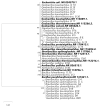Taxonomic Diversity and Antimicrobial Potential of Thermophilic Bacteria from Two Extreme Algerian Hot Springs
- PMID: 40572313
- PMCID: PMC12196180
- DOI: 10.3390/microorganisms13061425
Taxonomic Diversity and Antimicrobial Potential of Thermophilic Bacteria from Two Extreme Algerian Hot Springs
Abstract
This study investigated thermophilic bacterial communities from two Algerian hot springs: Hammam Debagh (94-98 °C), recognized as the second hottest spring in the world, and Hammam Bouhadjar (61-72 °C), one of the hottest in northwest Algeria. Thirty isolates were obtained, able to grow between 45 °C and 80 °C, tolerating pH 5.0-12.0 and NaCl concentrations up to 3%. Colonies displayed diverse morphologies, from circular and smooth to star-shaped and Saturn-like forms. All isolates were characterized as Gram-positive, catalase-positive rods or filamentous bacteria. Identification by MALDI-TOF, rep-PCR and 16S rRNA sequencing classified them mainly within Bacillus, Brevibacillus, Aneurinibacillus, Geobacillus, and Aeribacillus, with Geobacillus predominating. Rep-PCR provided higher resolution, revealing intra-species diversity overlooked by MALDI-TOF MS and 16S rRNA. A subset of six isolates, mainly Geobacillus spp., was selected based on phenotypic and genotypic diversity and tested for antimicrobial activity against thermophilic target isolates from the same hot spring environments. Strong inhibition zones (~24 mm) were observed, with Geobacillus thermoleovorans B8 displaying the highest activity. Optimization on Modified Nutrient Agar medium with Gelrite enhanced antimicrobial production and inhibition clarity. These findings highlight the ecological and biotechnological significance of thermophilic bacteria from Algerian geothermal ecosystems. While this study focused on microbial interactions within thermophilic communities, the promising inhibitory profiles reported here provide a foundation for future research targeting foodborne and antibiotic-resistant pathogens, as part of broader efforts in biopreservation and sustainable antimicrobial development.
Keywords: 16S rRNA; MALDI-TOF MS; antimicrobial peptides (AMPs); biotechnological applications; extreme environments; rep-PCR fingerprinting; thermophiles.
Conflict of interest statement
The authors declare no conflicts of interest.
Figures







Similar articles
-
Comparing microbial populations from diverse hydrothermal features in Yellowstone National Park: hot springs and mud volcanoes.Front Microbiol. 2024 Jun 27;15:1409664. doi: 10.3389/fmicb.2024.1409664. eCollection 2024. Front Microbiol. 2024. PMID: 38993494 Free PMC article.
-
Home treatment for mental health problems: a systematic review.Health Technol Assess. 2001;5(15):1-139. doi: 10.3310/hta5150. Health Technol Assess. 2001. PMID: 11532236
-
Genomic description of Microbacterium mcarthurae sp. nov., a bacterium collected from the International Space Station that exhibits unique antimicrobial-resistant and virulent phenotype.mSystems. 2025 Jun 17;10(6):e0053725. doi: 10.1128/msystems.00537-25. Epub 2025 May 20. mSystems. 2025. PMID: 40391897 Free PMC article.
-
Efficacy of nicergoline in dementia and other age associated forms of cognitive impairment.Cochrane Database Syst Rev. 2001;2001(4):CD003159. doi: 10.1002/14651858.CD003159. Cochrane Database Syst Rev. 2001. PMID: 11687175 Free PMC article.
-
Thermal stability and storage of human insulin.Cochrane Database Syst Rev. 2023 Nov 6;11(11):CD015385. doi: 10.1002/14651858.CD015385.pub2. Cochrane Database Syst Rev. 2023. PMID: 37930742 Free PMC article.
References
Grants and funding
LinkOut - more resources
Full Text Sources
Miscellaneous

